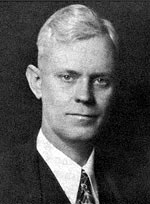Charles F. Roos (1901-1958)
 Director: September 1934 – January 1937; Advisor: September 1937 – 1939
Director: September 1934 – January 1937; Advisor: September 1937 – 1939
B.A., 1921; M.A., 1924; Ph.D., 1926; Rice Institute.
Charles F. Roos was director of research of the Cowles Commission from September 1934 to January 1937. He was National Research Council Fellow in mathematics 1926–28; assistant professor of mathematics at Cornell University, 1928–31; secretary of Section K (economics, sociology, and statistics), American Association for the Advancement of Science, 1928–31, and permanent secretary and member of the executive committee of that organization, 1931–33; fellow of the John Simon Guggenheim Memorial Foundation, 1933; director of research, National Recovery Administration, 1933–34; and professor of econometrics, Colorado College, 1934–37.
He was one of the founders of the Econometric Society; secretary-treasurer, 1931–32; secretary, 1932–36; vice-president, 1947; and president, 1948. He was a Fellow and was a member of the council of the Society.
He was a member of the International Statistical Institute and a Fellow of both the American Statistical Association and the Institute of Mathematical Statistics. He resigned from the staff of the Commission in January 1937 to accept a business research position and later organized the Institute of Applied Econometrics, Inc., now called The Econometric Institute, Inc. He later became president of that organization.
Approximately 60 of his papers on economics, statistics, and mathematics were published in the American Journal of Mathematics, Bulletin of the American Mathematical Society, Commercial and Financial Chronicle, Econometrica, Metron, Journal of Political Economy, Proceedings of the National Academy of Sciences, and Transactions of the American Mathematical Society.
He authored the following books: Dynamic Economics, 1934 (Monograph 10); NRA Economic Planning, 1937 (Monograph 2); Economic Measures, 1938; Dynamics of Automobile Demand, 1939; and Charting the Course of Your Business, 1948.
[Abstracted from A Twenty Year Research Report 1932–1952]